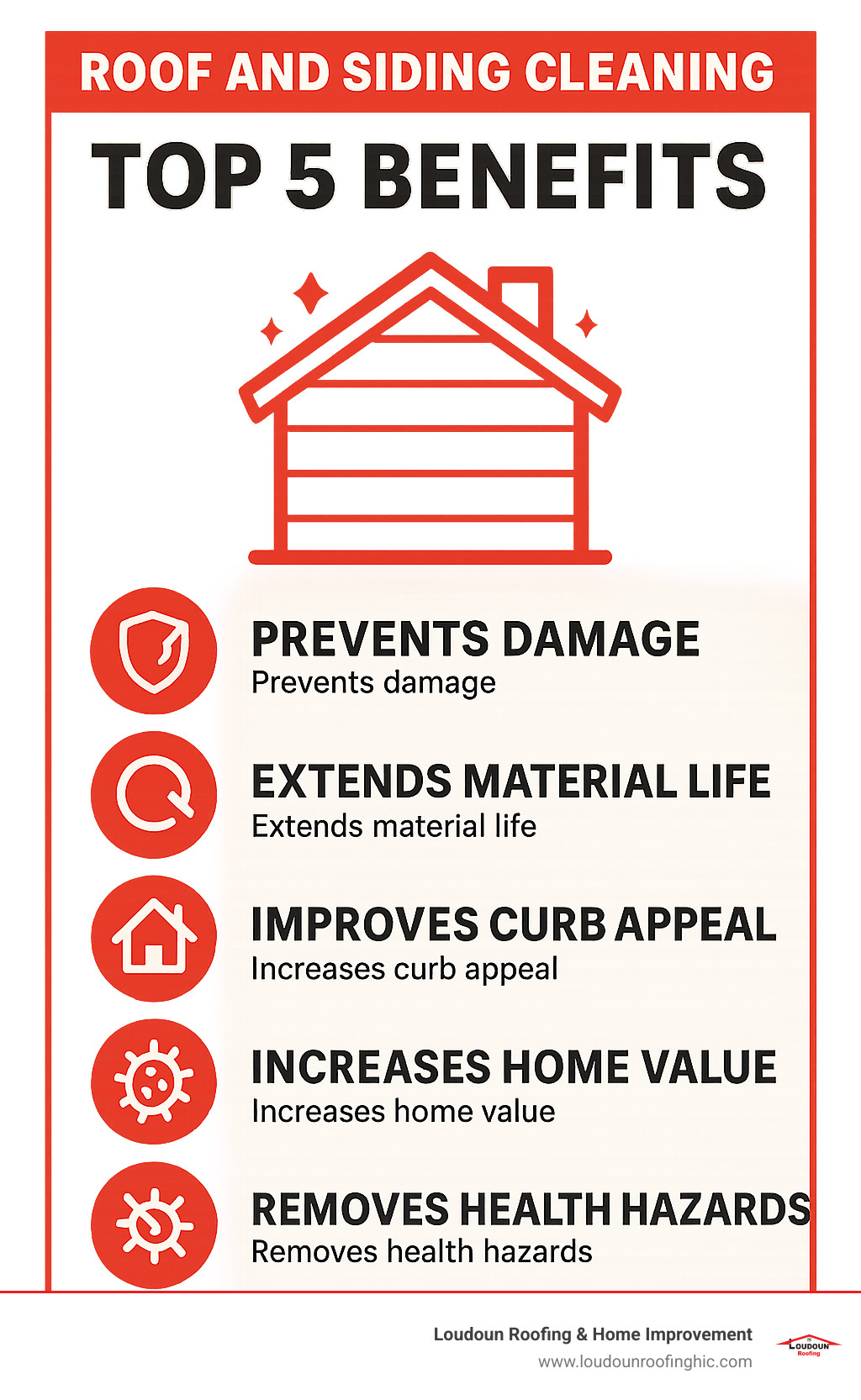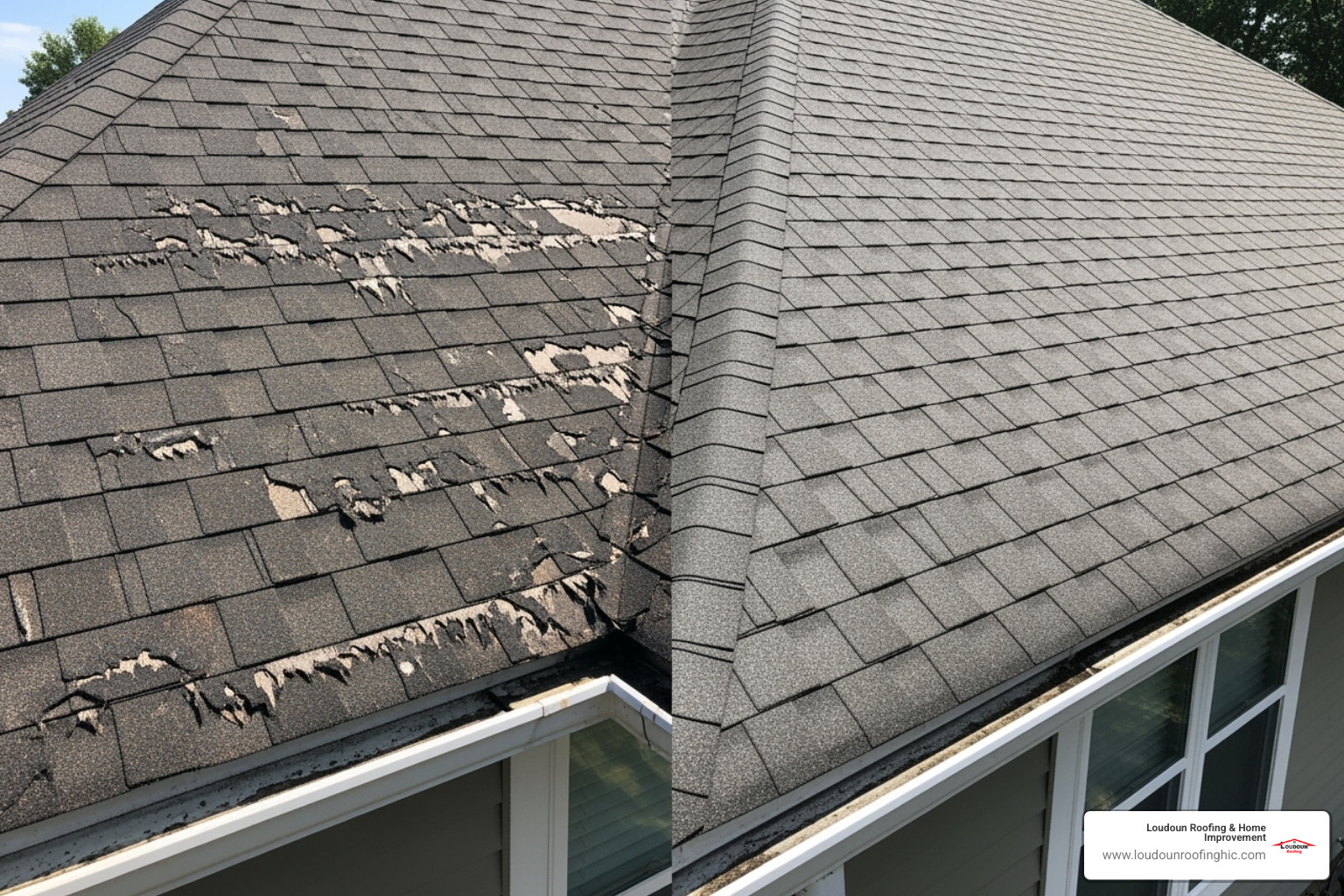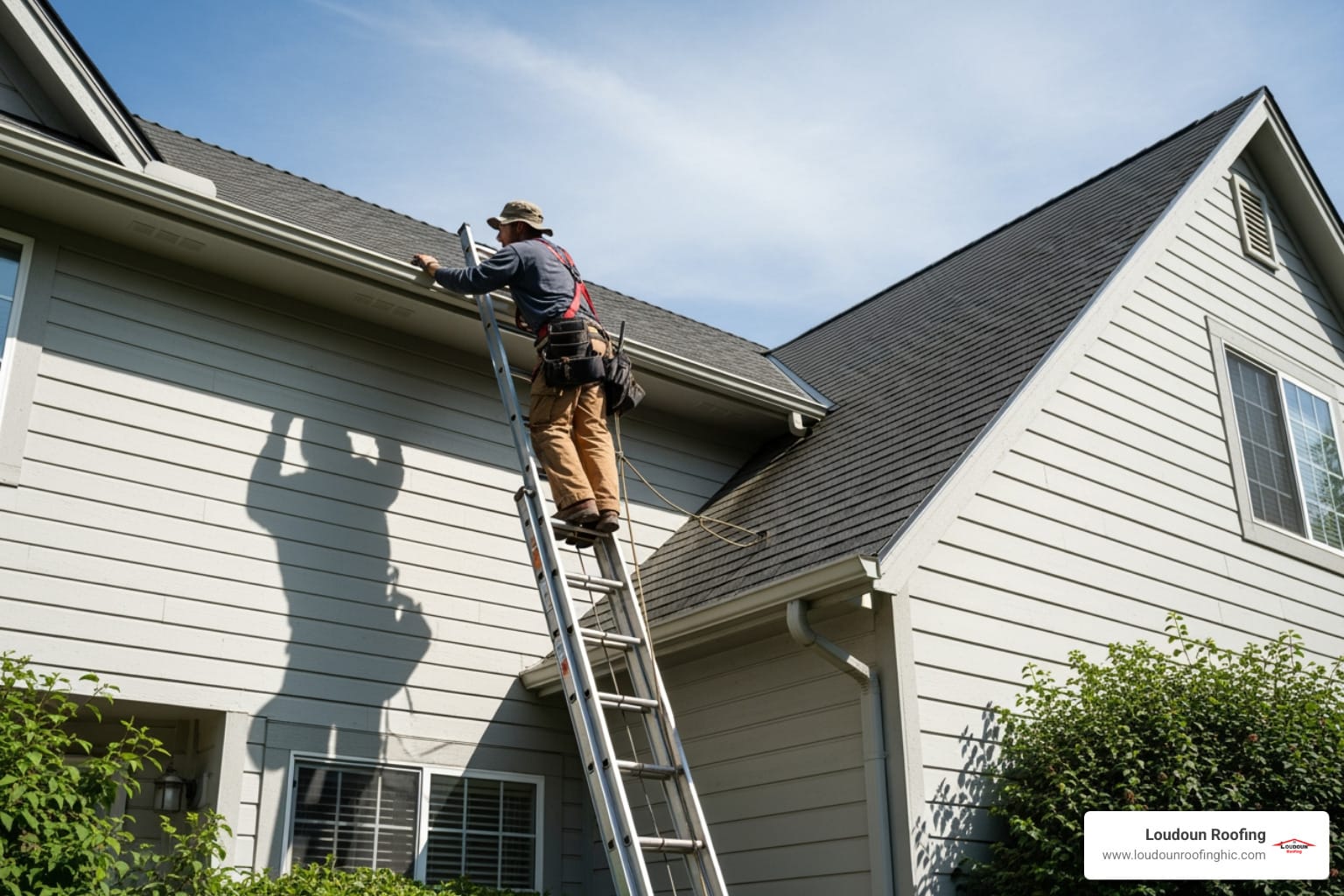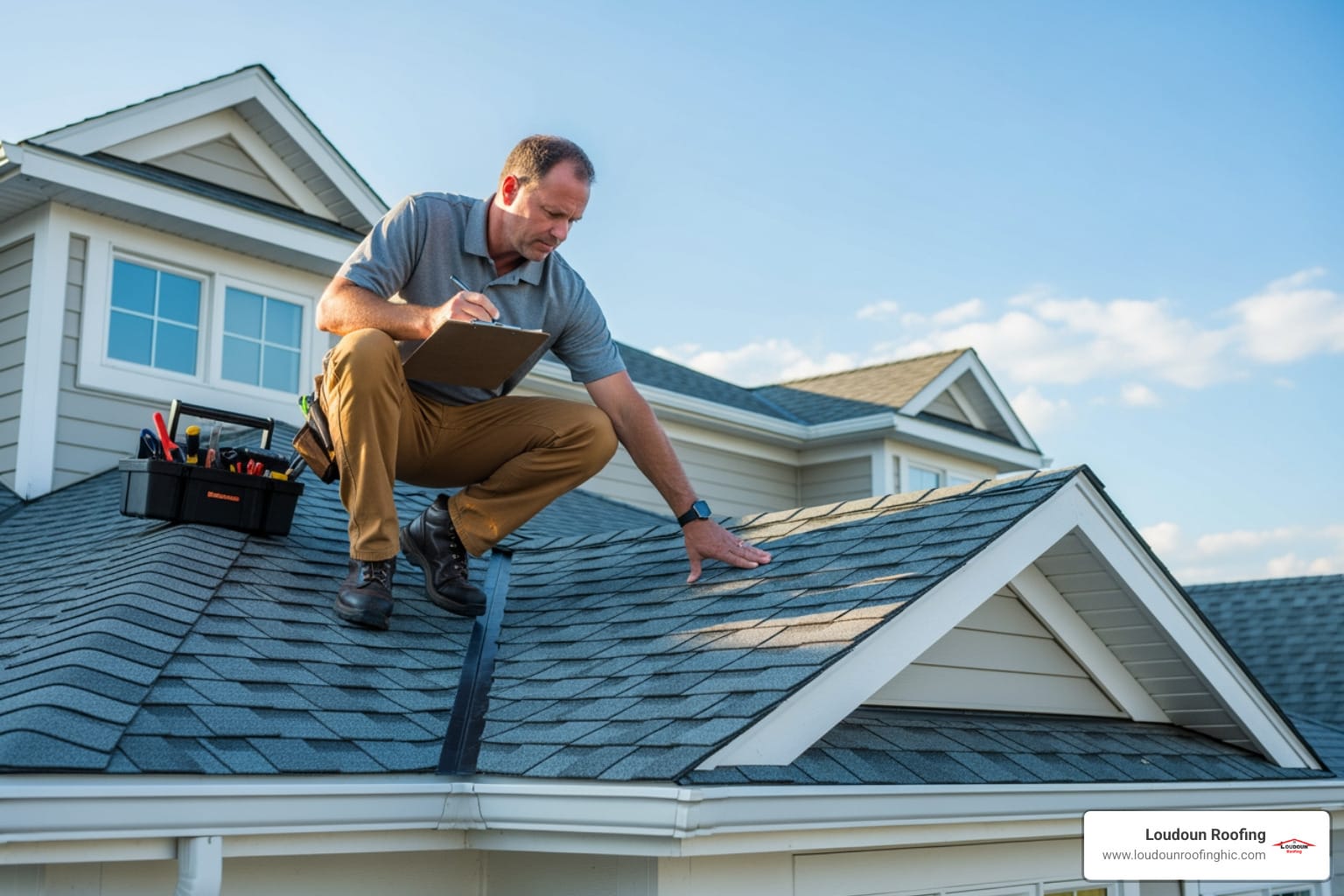Why Clean Roofs and Siding Matter More Than You Think
Roof and siding cleaning isn’t just about looks – it’s about protecting your biggest investment. Your home’s exterior faces constant attack from algae, mold, dirt, and weather, which can cause thousands in damage if left unchecked.
Quick Answer for Roof and Siding Cleaning:
- Method: Use soft washing (low pressure + specialized cleaners) instead of high-pressure washing
- Frequency: Every 1-3 years depending on climate and shade conditions
- Cost: Averages $455, ranging from $150-$1,000 ($0.20-$0.60 per square foot)
- Benefits: Prevents damage, extends material life, improves curb appeal, increases property value
- Safety: Always use proper equipment and consider professionals for steep or multi-story homes
A clean exterior does more than boost curb appeal. It prevents costly damage from organic growth that literally eats away at your roofing materials and siding. Regular maintenance is key to protecting your home’s exterior and preserving its value.
The difference between a $455 cleaning and a $15,000 roof replacement is often just regular maintenance. When black streaks appear on your roof or green growth covers your siding, you’re looking at more than cosmetic issues – you’re seeing the early signs of material breakdown.
As Esteban Marin, owner of Loudoun Roofing & Home Improvement with over two decades of roofing experience, I’ve seen how proper roof and siding cleaning can extend material lifespan by years. This guide will show you safe DIY methods and help you decide when to call the professionals.

The Big Payoff: Why Regular Cleaning is a Smart Investment
Here’s something most homeowners don’t realize: your home’s exterior is working 24/7 to protect everything inside. While we vacuum carpets and scrub bathrooms weekly, we often forget that roof and siding cleaning deserves the same attention – and actually delivers much bigger returns on investment.
Think about it this way: your home is probably your largest asset, and its exterior is like a protective shield constantly battling the elements. When that shield gets compromised by algae, mold, and grime, you’re not just looking at an eyesore – you’re watching your investment lose value in real time.
Curb appeal might sound like real estate jargon, but it’s actually dollars and cents. A clean, well-maintained exterior makes your home the standout on the block. Neighbors notice, visitors are impressed, and if you ever decide to sell, potential buyers see a home that’s been loved and cared for.
That improved appearance directly boosts your property value. Real estate agents will tell you that homes with clean roofs and siding not only sell faster but often command higher prices. It’s like giving your home a facelift without the massive renovation costs.
But here’s where it gets really important: regular cleaning is serious damage prevention. Those black streaks on your roof? That’s algae literally eating away at your shingles. The green stuff growing on your siding? It’s trapping moisture against your home’s exterior, creating perfect conditions for rot and structural damage.
By removing harmful growth before it takes hold, you’re stopping a slow-motion disaster. Algae feeds on the limestone in asphalt shingles, causing granules to fall off and exposing the underlying material to UV damage. Moss can actually lift shingles, creating gaps where water can sneak in and cause leaks.
Regular roof and siding cleaning dramatically extends material lifespan. Instead of replacing your roof in 15 years, proper maintenance might stretch that to 20 or 25 years. That’s thousands of dollars staying in your pocket.
Don’t forget the health benefits either. Mold and mildew growing on your home’s exterior can affect indoor air quality, especially problematic for family members with allergies or respiratory issues. A clean exterior means fewer allergens and spores around your living space.
The Cost of Cleaning vs. The Cost of Neglect
Let’s get down to the numbers that really matter to your wallet. Professional roof and siding cleaning averages around $455 for most homes. Depending on your home’s size, roof pitch, and the amount of cleaning needed, you might pay anywhere from $150 to $1,000. That typically works out to about $0.20 to $0.60 per square foot.
Now, here’s where the math gets really interesting. Compare that $455 average to what happens when you skip the maintenance. A full roof replacement? You’re looking at $15,000 to $30,000 or more. Siding replacement can easily run $10,000 to $20,000 depending on your home’s size and materials.
I’ve seen homeowners spend $25,000 on a new roof because they thought those black streaks were “just cosmetic.” Meanwhile, their neighbor who invested in regular cleaning every few years? Their roof is still going strong after 20 years.
The steep roof surcharge (an extra $0.15 per square foot for safety equipment and specialized techniques) suddenly doesn’t seem so expensive when you consider it’s protecting a $20,000+ investment, does it?
Think of regular cleaning as insurance for your home’s exterior. You wouldn’t skip car maintenance and then act surprised when the engine dies – your roof and siding deserve the same preventive care. That small, predictable expense every few years prevents those heart-stopping repair bills that always seem to come at the worst possible time.
Soft Washing: The Professional’s Secret to a Safe, Deep Clean
Think of soft washing as the gentle giant of exterior cleaning. While traditional pressure washing is like using a sledgehammer to crack a nut, soft washing is more like using the perfect tool for the job – effective yet careful.
Here’s what makes soft washing so special: it’s a low-pressure application method that relies on specialized cleaning solutions to do the heavy lifting. Instead of blasting away dirt and grime with brute force, soft washing lets chemistry work its magic. These specialized cleaning solutions are typically biodegradable and specifically formulated to break down and lift away stubborn contaminants.
The real game-changer? Soft washing actually kills algae and mold at the root. Rather than just washing the visible growth off the surface (where it can quickly return), the cleaning solutions penetrate deep and eliminate the organisms completely. This means your clean lasts longer – sometimes years longer than a simple pressure wash.
What makes this method perfect for roof and siding cleaning is that it’s safe for delicate surfaces. Your asphalt shingles and vinyl siding weren’t designed to withstand hurricane-force water pressure. Soft washing treats them with the respect they deserve, delivering a thorough clean without compromising their integrity.
The process is surprisingly straightforward: apply the cleaning solution at low pressure, let it work its magic for the recommended dwell time, then rinse with gentle pressure. The results speak for themselves – a deep, lasting clean that protects your investment.

Why High-Pressure Washing is a High-Risk
We get it – there’s something satisfying about the idea of blasting away years of grime with a powerful pressure washer. But when it comes to your roof and siding, high pressure is like bringing a cannon to a tea party. It’s overkill that can cause serious damage.
Let’s start with your roof. Those shingle granules aren’t just there for looks – they’re your roof’s sunscreen. High-pressure washing can strip these protective granules right off, leaving your shingles vulnerable to UV damage. Once those granules are gone, they’re gone for good, and your roof ages much faster.
For siding, the risks are just as real. High pressure can force water behind siding panels, creating a moisture problem inside your walls. This hidden water can lead to mold growth, rot, and structural issues you won’t find until it’s too late. Vinyl siding is especially vulnerable – that forceful stream can crack panels or create gaps where water can sneak in.
Then there’s the paint problem. High pressure loves to strip paint from surfaces, leaving you with an expensive repainting job on top of your cleaning bill. Even worse, many manufacturers will void warranties if you use high-pressure methods on their products. You could literally wash away your warranty protection along with the dirt.
The bottom line? High-pressure washing might seem faster and more dramatic, but it’s a gamble with your home’s most expensive components. Soft washing takes a little longer but protects your investment while delivering superior results.
The Ultimate DIY Guide to Roof and Siding Cleaning
Ready to roll up your sleeves and tackle roof and siding cleaning yourself? I love that DIY spirit! With the right approach and careful preparation, you can achieve professional-looking results while saving money. Let me walk you through everything you need to know to do this safely and effectively.
Essential Safety and Preparation
Before we dive into the fun stuff, let’s talk safety. I’ve seen too many weekend warriors get hurt because they skipped the basics. Trust me, a few extra minutes of prep can save you from a trip to the emergency room.
Gear up properly every single time. You’ll need safety goggles to protect your eyes from cleaning solution splashes, chemical-resistant gloves to keep your hands safe, and non-slip shoes with good traction. Wet surfaces are slippery surfaces, and you don’t want to learn that lesson the hard way.
Ladder safety is absolutely critical. Place your ladder on firm, level ground and have someone spot you if possible. Never overreach or lean too far to one side – it’s better to move the ladder multiple times than to take a dangerous tumble. The OSHA guidelines on safe cleaning practices provide excellent detailed safety information that’s worth reading before you start.
Protect everything around your work area. Cover your plants and landscaping with tarps or plastic sheeting. Even gentle cleaning solutions can harm delicate flowers and shrubs. Don’t forget to cover electrical outlets and move outdoor furniture away from the cleaning zone. If any solution accidentally gets on your plants, rinse them immediately with fresh water.
Check the weather forecast before you begin. You want a calm, dry day with no rain expected for several hours after application. Wind will blow your cleaning solution everywhere except where you want it, and rain will wash away your efforts before they have time to work.
The Recommended Process for Cleaning a Roof
Cleaning your roof is like giving your home a spa day – it needs gentle care and the right products. This process works beautifully for asphalt shingles, metal roofing, and tile.
Start by inspecting your roof thoroughly. Look for loose or damaged shingles, and address any repairs before cleaning. Clear away leaves, twigs, and other debris so your cleaning solution can reach the actual roof surface.
Choose your cleaner wisely – this makes all the difference. For most algae, moss, and mildew problems, oxygenated bleach or a dedicated roof cleaning solution designed for soft washing is your best bet. These products are formulated to kill organic growth without damaging your roofing materials. Always read the label carefully for specific mixing instructions and safety warnings.
Mix your solution according to the manufacturer’s directions in a large bucket or directly in your garden pump sprayer. This pump sprayer will become your best friend – it gives you the perfect low-pressure application that won’t damage your shingles.
Apply the solution evenly to affected areas, making sure you get good saturation. Pay extra attention to those black streaks and heavily stained sections. The key is patience here – let the dwell time work for you. This is when the cleaning solution penetrates and kills the organic matter at its roots.
After the recommended dwell time, rinse gently with a standard garden hose. We’re washing away loosened grime, not blasting it off. High pressure can strip away protective granules and force water under your shingles, creating bigger problems than you started with.
The Recommended Process for Cleaning Siding
Siding cleaning follows similar principles but varies depending on your material. Whether you have vinyl, wood, fiber cement, stucco, or brick, the soft-wash approach will treat your home’s exterior with the respect it deserves.
Prep your work area just like you did for the roof. Inspect for damage, protect plants and electrical outlets, and clear away obstacles. This preparation time always pays off with better results and fewer headaches.
Selecting the right cleaning product for your specific siding type is crucial. For vinyl, fiber cement, and painted wood, a quality exterior house wash with a touch of oxygenated bleach works wonderfully. For unpainted wood or specialty materials, look for cleaners specifically designed for those surfaces. Some concentrates work great when mixed at about 2 ounces per gallon of water.
Work in manageable sections – typically 10×10 foot areas work well. This prevents the cleaning solution from drying before you can rinse it, which would leave streaks and residue. Apply your cleaning solution with a pump sprayer, then let it dwell according to the product instructions.
For stubborn spots, gently scrub with a soft-bristled brush, always working from bottom to top. This prevents dirty runoff from streaking over areas you’ve already cleaned. When it’s time to rinse, work from top to bottom with thorough, complete coverage. Keep rinsing until no suds or cleaner residue remains – this step is crucial for preventing streaks and ensuring a beautiful, even finish.
The satisfaction of seeing your home’s exterior transform from grimy to gorgeous is incredible. Take your time, follow these steps, and you’ll achieve results that make your neighbors wonder if you hired a professional crew.
DIY vs. Hiring a Pro: Making the Smart Decision
Deciding whether to tackle roof and siding cleaning yourself or hire a professional doesn’t have to be overwhelming. Think of it like choosing between cooking dinner at home or going to a restaurant – both have their place, and the right choice depends on your situation, skills, and what you’re comfortable with.
Assessing the Job: Is DIY Right for You?
DIY suitability really comes down to a few key factors that we’ve seen make all the difference over our years in the business. If you’re looking at a single-story home, you’re already ahead of the game. Working at ground level or with minimal ladder use dramatically reduces risk and makes the job much more manageable for the average homeowner.
Light dirt and mildew are perfect candidates for a weekend DIY project. We’re talking about that thin layer of grime or minor discoloration that hasn’t had years to set in. Some homeowners tell us they’ve had great success with spray-on cleaners that cost around $20 and cover their entire house.
Having the right safety equipment isn’t negotiable, though. We can’t stress this enough – proper goggles, gloves, non-slip shoes, and a stable ladder are your best friends. If you don’t have these basics, factor that cost into your DIY decision.
Your time and physical ability matter too. Roof and siding cleaning can be surprisingly demanding work. If household maintenance chores are becoming challenging, or if your weekends are already packed, DIY might add more stress than savings to your life.
When to Call the Experts for Roof and Siding Cleaning
Some jobs simply call for professional suitability, and there’s no shame in recognizing when you’ve met your match. Steep roofs are where we see the biggest difference between DIY attempts and professional results. These surfaces often require additional safety measures and specialized equipment that most homeowners don’t have lying around in their garage.
Multi-story homes present their own challenges. Professional teams come equipped with lifts, advanced fall protection, and the training to use them safely. We’ve seen some companies that put their teams through over 150 hours of training – that’s not something you can replicate with a YouTube video.
Heavy staining or algae growth is another area where experience really shows. Those thick black streaks or moss-covered sections need stronger solutions and specific techniques that professionals have perfected over thousands of cleanings. A simple DIY spray often just isn’t enough for severe infestations.
Safety concerns should always trump cost savings. If you’re uncomfortable with heights, ladder work, or handling cleaning chemicals, trust that instinct. Professional cleaners carry liability insurance and have the training to handle these challenges safely.
For complex jobs or when you want that peace of mind, consider professional roof maintenance services to ensure it’s done right. Since 2000, we’ve completed hundreds of thousands of cleanings, and sometimes that professional touch really is invaluable – not just for the results, but for your safety and sanity too.
Frequently Asked Questions About Exterior Cleaning
Over the years, we’ve helped countless homeowners understand the ins and outs of roof and siding cleaning. Here are the questions that come up most often, along with straightforward answers based on our experience.
How often should I clean my roof and siding?
Most homes benefit from roof and siding cleaning every 1 to 3 years, but your home might need it more or less frequently depending on where you live and what’s happening around your property.
Climate plays a huge role in how quickly your exterior gets dirty. If you live in a humid area like Northern Virginia, you’ll likely see algae and mold appearing faster than homes in drier climates. The moisture in the air creates perfect growing conditions for these unwanted guests.
Shade is another big factor. Homes tucked under lots of trees or in naturally shaded areas stay damp longer after rain, which means algae and mold have more time to take hold. While those beautiful oak trees provide great summer cooling, they also drop leaves, sap, and debris that create a perfect breeding ground for growth.
Overhanging branches deserve special attention. They don’t just drop leaves – they keep your roof damp and block sunlight that would naturally help keep surfaces dry. If you’ve got branches hanging over your roof, you might find yourself cleaning more often, or better yet, consider trimming them back.
The good news? Many professional cleaning products can keep surfaces free of moss, mold, and mildew for over a year in most cases. The key is watching your home and acting when you first notice those telltale dark streaks or green patches starting to appear.
Can cleaning damage my roof or siding?
Unfortunately, yes – improper cleaning methods can cause serious damage to your roof and siding. We’ve seen it happen more times than we’d like to count, which is why we’re so passionate about educating homeowners on safe cleaning practices.
High-pressure washing is the biggest culprit. That powerful stream of water might seem like it’s doing a thorough job, but it can strip the protective granules right off your asphalt shingles. Once those granules are gone, your roof loses its main defense against UV rays, and you’re looking at premature aging and potential replacement.
For siding, especially older vinyl siding, high pressure can force water behind the panels. This leads to moisture problems inside your walls – think mold, rot, and structural damage that’s expensive to fix. We’ve also seen pressure washing strip paint from surfaces and even void manufacturer warranties.
The soft washing technique we recommend is completely different. It uses specialized, biodegradable cleaning solutions that do the work chemically, breaking down and lifting contaminants without the need for harsh pressure. When done correctly with the right products, this method is safe for your home’s materials and effective at removing growth.
Always check product labels for your specific roof and siding materials, and when in doubt, it’s worth consulting with professionals who understand the nuances of different surfaces.
What are the black streaks on my roof?
Those dark, unsightly streaks running down your roof aren’t just dirt – they’re actually Gloeocapsa magma algae, a type of blue-green algae that loves to make itself at home on asphalt shingles.
This algae is particularly sneaky because it feeds on the limestone filler that’s commonly used in asphalt shingles. As it grows and spreads, it forms those characteristic dark colonies that make your roof look aged and dirty. What makes it worse is that this algae retains moisture, keeping your roof damp longer after rain and accelerating the breakdown of your shingles.
While some lighter green stains might fade within a few weeks with the right treatment, these established black streaks are much more stubborn. Long-established Gloeocapsa magma stains can take 6 to 12 months to completely disappear, even with professional-grade cleaners.
This is why professional removal is often the best approach. The algae needs to be killed at the root to prevent it from coming back, and that requires specific algaecides and soft washing techniques that most homeowners don’t have access to. Trying to blast it off with pressure washing will only damage your shingles while potentially spreading the algae to other areas of your roof.
The longer you wait to address these black streaks, the more established they become and the harder they are to remove completely.
Conclusion: Protect Your Investment with a Clean Home
Your home is more than just four walls and a roof – it’s your biggest investment and your family’s safe haven. Throughout this guide, we’ve shown you how roof and siding cleaning transforms from a simple chore into a powerful strategy for protecting everything you’ve worked hard to build.
The benefits speak for themselves. A clean exterior doesn’t just make your neighbors smile when they drive by (though that’s a nice bonus). It actively boosts your property value, prevents thousands in damage from sneaky organic growth, and extends the life of your roofing and siding materials. When you consider that the average cleaning costs just $455 compared to a $15,000+ roof replacement, the math becomes pretty clear.
We can’t stress this enough: soft washing is your safest bet. Those high-pressure washers might look impressive at the hardware store, but they’re like using a sledgehammer to hang a picture frame. The gentle approach of soft washing gets the job done without stripping granules, forcing water behind siding, or voiding your warranties.
Whether you tackle the job yourself or call in the pros depends on your specific situation. Regular maintenance saves money – it’s that simple. A single-story home with light staining? You might enjoy the satisfaction of a DIY weekend project. But steep roofs, heavy algae growth, or safety concerns? That’s when experience and professional equipment make all the difference.
At Loudoun Roofing & Home Improvement, we’ve been helping homeowners throughout Leesburg, Ashburn, Sterling, and all of Loudoun County keep their homes beautiful and protected for years. We know these Virginia homes face unique challenges from our humid summers and changing seasons, and we’ve got the expertise to handle whatever Mother Nature throws your way.
Ready to give your home the care it deserves? Call us today at (703) 777-9207 or request a free estimate to restore your home’s beauty and protect your investment for years to come. Your future self (and your wallet) will thank you.



